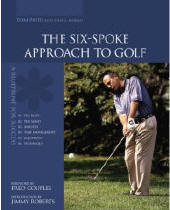The Six-Spoke Approach to Golf
Let’s face it. For all but a very rare few, golf is a remarkably difficult game to learn how to play.
You stand sideways, holding a long rod that you’re supposed to swing around you in order to hit a tiny ball that’s only as wide as two or three fingers, sitting there in front of your feet. If you do it right, the result is a thing of beauty. If you don’t, and that’s the norm for most beginners, it’s some kind of wretched squirffy bouncer–and that’s if you hit the ball, instead of whiffing entirely.
Frankly, it’s a wonder that more folks don’t quit the game after their first ten swings or so.
On the other hand, the difficulty of the sport may also be why it’s so compelling, and what convinces beginners to keep trying. The first few tries that actually take off provide a tremendous amount of positive feedback.
Many golf instruction books aimed at beginners focus on the particular elements of that golf swing, which is perfectly understandable in one sense. Why discuss strategy when you don’t even know how to hold the club? Nonetheless, those who’ve taught and played the game know that there’s so much more to playing golf than the basic swing elements.
Tom Patri is one of those folks. He’s a former Division II NCAA golf champion and a long-time teaching pro in New York State and Florida. Patri is among the Top 100 Teachers in America, according to Golf Magazine.
He’s convinced that even beginners should learn how to integrate the basic swing into all of the other parts of the game, which he’s divided into six spokes—The body, the mind, analysis, time management, equipment, and technique.
The first section is devoted to convincing the reader that golf is an athletic endeavor, with potentially significant physical impacts on its players. This is stark contrast to the old cartoon showing two fat guys standing next to a cart and holding beer cans, as one says, “Golf is a sport. Therefore we are athletes.”
Patri’s right, of course, even if the two guys from the cartoon can be seen at every golf course. The swing speeds that even raw beginners can generate put a sizeable strain on muscles that may not have seen much of a workout since middle-school gym class. It makes perfect sense to teach golfers how to prepare and maintain their body for the actual rigors of the sport, with a combination of stretching and strengthening exercises.
The second spoke emphasizes the mind’s effect on the golfer. Experienced players know from bitter familiarity, for example, how the last thing the brain hears when one thinks “Don’t hit it there,” is “Hit it there.” It’s just amazing how accommodating our muscles are to those last-second directives. Petri discusses how to combat this and other problems of bringing the proper mental focus to the tasks at hand.
The analysis spoke is aimed at golfers who’ve been playing a while and who want to improve. Petri explains how careful review of actual playing results, shot by shot and hole by hole, with the helpful intervention of computer software designed for this purpose, will help golfers understand which parts of their game really need to be addressed.
In some respects the time management spoke is a test of your commitment to improvement. Again, except for a very rare few, playing better golf requires an investment of time that many folks just don’t make. Small wonder, then, that the average handicap among men and women golfers hasn’t significantly improved, even with the major advances in ball and club technology. Fortunately, Petri shows how to use the time made available to your best advantage.
The equipment segment dovetails nicely with the advice imparted earlier this year in Tom Wishon’s Search for the Perfect Golf Club. Petri agrees that beginners should be among the first folks lined up to be fitted, instead of just buying the clubs with the most TV commercials. His suggestions are well worth adopting to your approach to filling out your set.
The final segment, technique, reminds golfers that the short game is where the most improvement can be made the fastest. It’s also the least physically demanding element of the game. The real wonder is why more players don’t approach their practice sessions with these facts in mind.
Petri takes his readers from putting to chipping to pitching first, and only then addresses the full-swing elements of the longer clubs. That’s not a lesson in patience—it’s really a reminder to put first things first.
Golfers who hear their non-golfing friends talk about taking up the sport could do their buddies a real favor by giving them this book. It will help keep them on the right path to learning and improving their new game.
Review date: August 20, 2005


